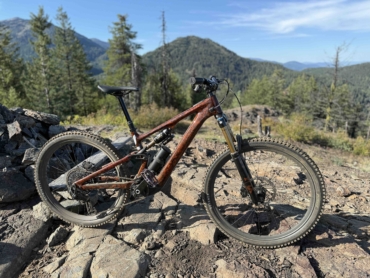The bottom bracket of a bicycle is the lynchpin that allows riders to pedal.
These components either screw or press into a frame to attach cranksets and enable them to spin. At first glance, a bottom bracket can seem like a pretty straightforward component. But as with seemingly every part of a modern bicycle, nothing could be farther from the truth.
In decades past, bottom brackets tended to be more uniform. Bike manufacturers almost exclusively made bikes with materials like steel and aluminum. With these materials, manufacturers could easily cut threads into a bottom bracket shell so the bottom bracket could screw directly into a frame.
However, this became a problem when carbon bikes arrived on the scene.
Carbon does not take well to threading, so manufacturers had to develop a new way to fit the bottom bracket to a bike. Some opted to create threaded inserts that bottom brackets could screw into.
Others went with a press-in option with no threading at all. So many brands addressed the issue separately that now there is a litany of bottom bracket standards that make the term “standard” almost laughable.
Threaded Bottom Bracket Standards

Threaded bottom brackets screw into threads in a bicycle’s frame.
Among the most common standards in the threaded bottom bracket category is the BSA, also known as the English (ENG) standard or ISO. The BSA standard uses 1.37 (34.8mm) x 24 threads per inch, with the non-drivetrain side of the bike threading counterclockwise while the drivetrain side tightens clockwise.
Many bikes made from aluminum or other metals use this option.

The T47 is a newer threaded bottom bracket standard. This standard incorporates an adapter of 47mm in diameter x 1mm pitch. The adapters, or “cups,” house the bearings in which a crank spindle turns. These cups screw into the frame the same way as BSA, with the non-drive side spinning clockwise and the drivetrain side turning counterclockwise.
The Italian standard, which features 36mm x 24 threads per inch, isn’t as common, but it is out there. One key difference between the Italian standard compared to the others is that both the drivetrain and non-drivetrain sides turn clockwise.
Threaded bottom brackets tend to be heavier than their press-fit counterparts, as they require more material for threading. However, they have become a godsend for many who work on their bikes because they are far easier to deal with at home.
Press-fit bottom brackets require a tool that can cost hundreds of dollars, while threaded bottom brackets are easy to install or remove with a wrench.
That means threaded bottom brackets can typically be serviced without visiting the local bike shop.

Press-Fit Standards

Press-fit bottom bracket bearings are pressed into the frame where threaded brackets would screw in. They can use cups with outer bearings like threaded counterparts or interior bearings that affix inside a bike frame.
They have a slightly larger diameter than the frame opening, so they hold via pressure and friction. Press-fit bottom brackets require precise manufacturing, as any looseness can result in annoying squeaking.
According to Park Tool, the press-fit legion contains many designs with confusing variations.
“The terminology of press-fit bottom brackets has become especially confusing,” Park Tool says. “Some standards were named for the spindle diameter, others were named for the shell width, and still other terms came from the size of the bore where the press-fit occurs. Because the frame shell bore diameter is the only consistent and most important part of the press fit system, the bore size is the preferred system and will be used here.”

The PF41 standard uses a 41 mm inside diameter. According to Park Tool, this standard also includes the BB86, BB89.5, BB92, BB107, BB121, BB132, PF24, and Shimano Press-Fit.
If those numbers seem confusing, you’re not alone. Here’s how Park Tool explains it all:
“The numbers ranging from 86 to 132 refer to the nominal width of the shell in millimeters, which is not related to the press fit of the bearings. These bottom brackets will vary in the width of the dust sleeve used for that different widths,” according to Park Tool.
“The term ‘Shimano® Press-Fit’ refers to the company that developed bottom bracket components in this standard. The term PF24 is for bearing adapters fitting a 24mm spindle that use a 41mm bore frame.”
The PF 42 standard, like the PF41, is also known as BB30, BB30A, BB30AI, and BBRight Direct Fit. The BB30, which began as a proprietary design from Cannondale, was the first press–fit “standard.” However, the brand decided to open the BB30 for others to use as a more open standard. The BB30A, BB30AI, and BBright have asymmetrical designs.
Since then, Cannondale has created its proprietary BB30A and BB30-83 AI, the BB30A.

The PF46 standard also has many other monickers, including the PF30, PF30A, PF30AI, BB386EVO, OSBB, and BBright Press Fit. PF30 was an early term denoting the difference between the PF46 and PF42 standards. According to Park Tool, the 46 in PF46 comes from the 46mm bore of the frame shell the bottom brackets use.
“The frame shell has a smooth bore with an approximately 46mm inside diameter. The shell widths range in width from 68mm to 86mm,” according to Park Tool.
“The cartridge bearings of the PF46 system use an adapter of plastic or aluminum and are pressed into the bottom bracket shell. Bearing adapters are made to fit different crank spindle diameters, such as 22/24mm, 24mm, 28.99mm, and 30mm.”
Trek released the BB90 and BB95 as its standards in 2007. The bearings are pressed directly into the frame rather than into exterior cups. This created more space in the bottom bracket area of the frame for larger tubes and the increased shell widths of 90mm on road bikes to 95mm on mountain bikes.

Press-fit bottom brackets require expensive tools specifically made for that purpose. They are usually too expensive for a home mechanic to consider purchasing, and misuse can permanently damage a frame.
Bottom Bracket Compatibility
Most of these bottom bracket standards do not work well together. However, they have become so frustrating that many companies have created adapters and accessories to make them function together.
Still, since there is so much variability in the standards, the best way to ensure that the bottom bracket you have your eye on will work is to pay close attention to the exact measurements of each standard — and never assume anything will work without checking first.
Bottom brackets usually garner little attention, as they only become an issue when something goes wrong. But you can save time, energy, and frustration by knowing precisely what you are running before that day ever comes.







